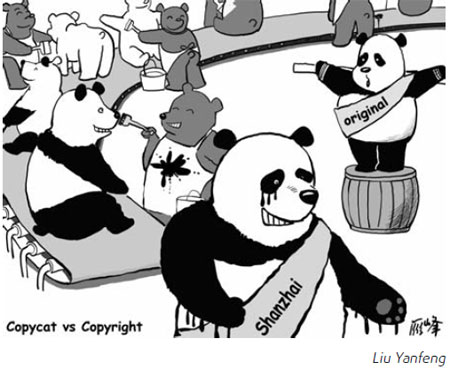
|
OPINION> Commentary
 |
|
Copycat culture harms holders of IP rights
By Yao Ying (China Daily)
Updated: 2008-12-06 08:03  A recent video about a small street in Nanjing, Jiangsu province, is amusing, but also thought-provoking. It has attracted many Web users in China. The video captures various "well-known" brands on the street: Pizza Huh, Bucksstar Coffee, I-Eleven, Haagon-Bozs The logos resemble the originals in such a "creative" way that one netizen commented, not without ridicule, "it is definitely a new achievement in human imagination". It was later suspected to be a marketing ploy to rent new shops on the street at a better price, for the logos disappeared within days after the video was put online. The street does not actually sell rip-off brands. However, it is now dubbed a shanzhai street as the visual impact best illustrates the wildly popular copycat culture in China, which is embodied in this buzzword. "Shanzhai literally means mountain villages which are remotely located and usually out of administrative control. The word was first used to describe underground factories in southern China where local manufacturers made rip-off world-class brands. The term now refers to all kinds of off-brand and knock-off products. It can also describe things that are improvised or home-made. We have the shanzhai edition of computers, costumes, cars, movies, TV series, pop stars, and buildings such as the Tian'annmen Rostrum and the White House. The shanzhai culture as a celebration of the DIY spirit or as a parody to mainstream culture can add fun to our daily lives. However, we should remain vigilant against it as a justification for rip-off products. Lately there has been a tendency in the public discourse to rationalize, justify or even glorify such intellectual property (IP) rights violations. Take shanzhai mobile phones as an example. The majority of shanzhai handsets copy the latest models of brand names in every detail, both in function and appearance. Reportedly, it generally takes two months for a registered handset maker to have a new model pass official tests, while unregistered imitators do not have to go through that procedure. The copycats take advantage of the time window to copy the original design, make the handset, sell it at a much lower price and reap huge profits before the brand name one can even make it to the market. It is estimated that the number of shanzhai handsets produced last year was 150 million, about one-third of the domestic market. They are also sold in Southeast Asia, Africa and the Middle East, posing a big threat to the legal manufacturers. Some say that knock-off mobile phones exist for a good reason: Consumers benefit greatly as the handsets come at a fraction of the price of the original. The ongoing financial crisis may also have a role to play in some consumers' growing interest in the shanzhai edition of products. It has become almost a trend to find ways to spend less for more. However, no matter in what times we find ourselves, consumers interests should not be at the expense of legitimate IP right holders. IP laws are there to protect the interests of patent, copyright and trademark holders for a limited period of time. They are devised not only to reward innovators, but also to encourage further creativity. Imitators make money by evading license fees and shunning investment in research and development. If they are not held accountable, society is rewarding copycats while punishing innovators. The result could be catastrophic: Everyone will choose to copy others because R&D is not compensated. The market will be flooded with the same kind of poorly-designed and badly-made products that have short lives and lack after-sale services.
Some people may argue that there is a certain degree of innovation in shanzhai products. Yet how much creativity is involved when the only modification a certain knock-off iPhone has made is to name itself Hi-Phone? Or can you call it innovation when another copycat turns this popular Apple product into a clamshell style phone? And how about KFG vs KFC and adidos vs adidas? Some even compare shanzhai to the garage culture in Silicon Valley, where Steve Jobs and Steve Wozniak designed the Apple 1 computer, and William Hewlett and David Packard launched the HP. Shanzhai culture is fundamentally different because it is far from being innovative, which is key to the development of science and technology. If underground manufacturers in China want to grow big some day, they will have to do much more than play simple tricks. The problem is that few harbor such dreams: All they care about is to make quick money. Why take risks by investing in R&D in a market where trends change every few months? Still there are some people who justify the need for knock-off brand names by claiming that it is the licensed producers that are ripping off consumers by charging too high a price. It may be true that some big brands make mistakes in pricing in a developing country such as China. And the errors may finally cost them dearly in the market. However, it is unreasonable to let them pay a price by infringing upon their IP rights. The illogical link some people make between these two separate issues reflects the lack of respect for IP laws in China. In recent years, IP awareness among Chinese people has been improved and the government has been constantly battling against piracy. One noticeable change is that pirated DVDs are now much more difficult to come by on the streets. But the current popularity of the copycat culture under the name of shanzhai may turn out to be a disservice to that healthy trend. While some imitations may make you laugh, but the ones that shake IP protection to its very foundations will destroy our long-cherished hope to see more Created-in-China products in the market. Implementation of IP laws should be strengthened to curb such illegal practices. (China Daily 12/06/2008 page4) |